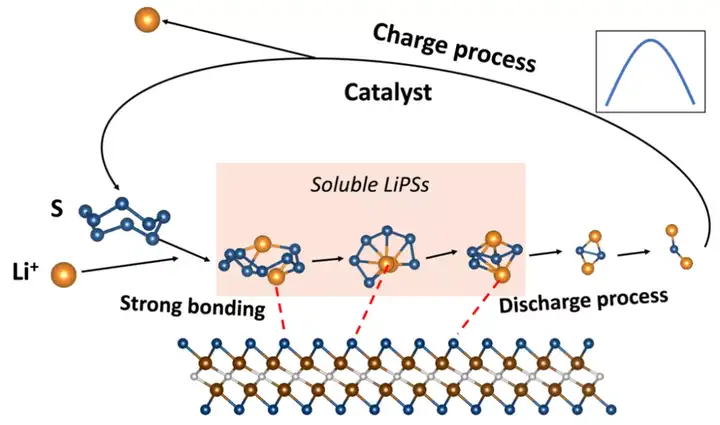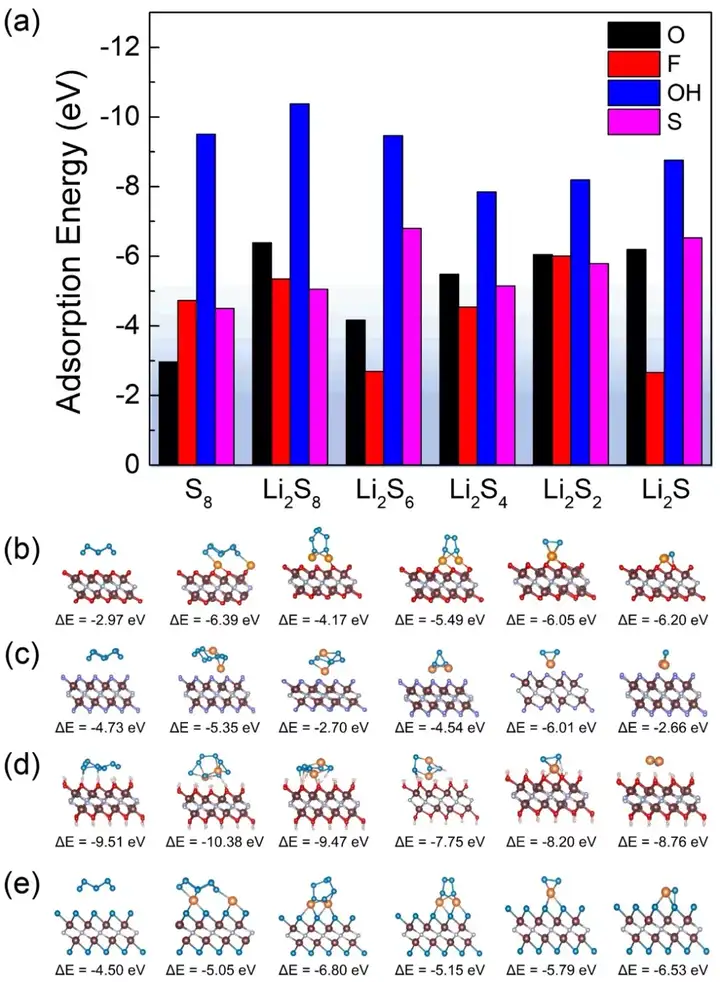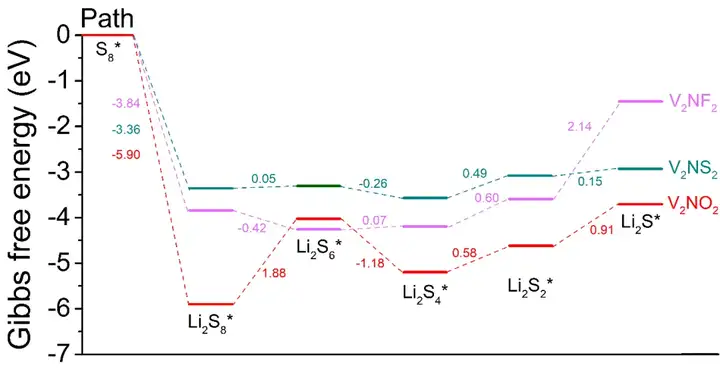Professor Huang Haitao from Hong Kong Polytechnic University, Professor Luo Xin from Sun Yat-sen University JMCA: Nitride MXene as a sulfur cathode host material inhibits the shuttle effect of polysul
Nitride MXene as a Sulfur Cathode Host Material--Suppressing the Shuttle Effect of Polysulfur Compounds from Both Thermodynamics and Kinetics
First author: Fan Yan Corresponding author: Huang Haitao, Luo Xin Affiliation: Hong Kong Polytechnic University, Sun Yat-sen University
Research Background
Lithium-sulfur Li-S batteries have received widespread attention due to their high theoretical specific capacity of 1675 mAh g-1 and high theoretical specific energy of 2600 Wh kg-1. However, its practical application is limited by the poor conductivity of the sulfur anode, the shuttle effect of lithium polysulfide LiPS, and the slow charging and discharging process. In the past, a lot of research work focused on developing various methods to inhibit the dissolution and shuttle of LiPS. However, few people pay attention to suppressing the shuttle effect of polysulfides from both thermodynamics and kinetics, thereby improving the utilization efficiency of lithium polysulfides. Compared with carbide MXenes, nitride MXene shows better conductivity and ability to adsorb polysulfides. The characteristics of vanadium nitrides with multivalent states from V2+ to V5+, stable crystal structure of the formed compound, and abundant reserves in the earths crust give it great potential as a sulfur host material. This research work is the first to discuss the anchoring ability of V2N-based materials to polysulfides, sulfur reduction during discharge, conversion kinetics of Li2S decomposition during charging, and related bifunctional catalytic effects. .
Introduction to Articles
Here, Professor Huang Haitao from Hong Kong Polytechnic University and Professor Luo Xin from Sun Yat-Sen University jointly published the title Nitride MXenes as sulfur hosts for thermodynamic and kinetic suppression of polysulfide shuttling: a computational study in the internationally renowned journal Journal of Materials Chemistry A. Article. This article discusses the potential of nitride MXene V2N as a sulfur cathode host material. Through first-principles calculations of its electronic properties, anchoring strength, reaction barrier and catalytic ability, we found that the anchoring strength and bifunctional catalytic ability of single-layer V2NT2 T = -O, -F, and -S can be Adjust by surface functional groups.

The main points of the article
Point 1: The anchoring effect is thermodynamically. The anchoring effect of the V2N and V2NT2 monolayers is evaluated by calculating the adsorption energy. Through a comprehensive energy scan search for each S8 and Li2Sn n=1, 2, 4, 6 and 8 clusters, the adsorption sites with the lowest energy are obtained, and the optimal adsorption position of LiPS is determined. The calculation results show that the V2N material has a strong adsorption effect on LiPS, so that S8 and Li2Sn are easily decomposed into single S and Li atoms, which are then tightly captured by the V atoms in the outermost layer of V2N. On the contrary, the V2NO2, V2NF2 and V2NS2 monolayers have moderate adsorption strength for LiPS. During the adsorption process, the LiPS structure remains stable, which is thermodynamically beneficial to inhibit the dissolution and shuttle of LiPS.

Key point 2: During the discharge process of lithium polysulfide conversion, S8 is first reduced to long-chain soluble LiPS Li2S8, Li2S6 and Li2S4, and then further reduced to short-chain insoluble LiPS Li2S2 and Li2S, which reduces the energy of the reduction reaction. The barrier is beneficial to speed up the reduction reaction process and shorten the accumulation time of LiPS in the positive electrode, thereby further inhibiting the dissolution and shuttle of LiPS. It is worth noting that V2NS2 shows the lowest sulfur reduction reaction Gibbs free energy barrier 0.49 eV, soluble Li2S4 to insoluble Li2S2 during the discharge process, which kinetics contributes to the rapid formation of insoluble Li2S2, thereby inhibiting Dissolution of LiPS.

Key point three: Li2S decomposition process Li2S decomposition kinetics during charging is also crucial to the electrochemical performance of Li-S batteries. The functionalized V2NT2 modified with surface functional groups exhibits excellent Li2S decomposition catalytic ability during the charging process, and the corresponding reaction energy barrier is reduced from 3.64 eV for V2N to 1.55 eV for V2NO2 and 1.19 eV for V2NS2. This means that Li2S decomposition kinetics are improved, thereby accelerating the entire charging process of Li-S batteries.
Key point 4: In this work, we studied the potential application of 2D V2N/V2NT2 monolayer as a positive electrode host material for Li-S batteries through DFT calculations. The results show that both unmodified and functionalized MXene monolayers exhibit excellent metallic properties. However, due to the extremely strong V-S or V-Li bonds, unmodified V2N materials cannot be directly applied to Li-S batteries. Among the four functional groups O/F/OH/S studied, through comprehensive analysis of metal properties, LiPS anchoring ability, Li2S decomposition barrier and discharge process dynamics, the V2NS2 monolayer was determined to be the most promising Candidates for host materials. This research opens up a new way for the rational design of nitride MXenes and other new two-dimensional materials as potential host materials for lithium-sulfur battery cathodes.
Article link
Nitride MXenes as sulfur hosts for thermodynamic and kinetic suppression of polysulfide shuttling: a computational study https://doi.org/10.1039/D1TA06759A
Brief Introduction of Communication Author
Professor Huang Haitao. Professor of the Department of Applied Physics, Hong Kong Polytechnic University. Has long been engaged in the preparation, performance characterization and physical mechanism research of dielectric materials and new low-dimensional nanostructured new energy materials. So far, he has published about 300 papers in internationally renowned academic journals including Nature, Nature Photonics, Nature Communications, Journal of the American Chemical Society, Energy & Environment Science, Advanced Materials, Joule and Chem, which have been cited more than 13,000 times. Co-edited the book Ferroelectric Materials for Energy Applications with Father of Integrated Ferroelectrics Professor J.F. Scott. He was awarded the second prize of Science and Technology by the Ministry of Land and Resources (2017) and the second prize of Natural Science for Outstanding Scientific Research Achievements of Higher Education of the Ministry of Education 2019. He is currently the associate editor of the international academic journal Advanced Materials and Devices and the editorial board of several SCI journals. Elected as a council member of the International Academy of Electrochemical Energy Sciences IAOEES in 2019.
Xin Luo Professor, School of Physics, Sun Yat-sen University. He has long focused on the microstructure design of low-dimensional functional materials, material preparation and performance development and application research, especially good at micro-nano low-dimensional materials, such as the surface physics, physical mechanics and surface interface of two-dimensional materials Research on the physical properties and mechanisms related to photoelectromagnetism. Among them, the force-electromagnetic coupling effect of two-dimensional ferroelectric semiconductors, the development of graphene-like materials and intercalation structures, and the research of two-dimensional materials in energy storage have received high praise and attention from international counterparts and professional media. Published more than 50 SCI academic papers in international journals. The first author and corresponding author published papers in Nature, Nature Chemistry, Physical Review Letters, Nature Communications, Nano Letters, JACS, ACS Nano and other journals. Three papers were selected by ESI High Cited papers. He was awarded the outstanding youth of Guangdong Province, and now serves as the guest editor of the international academic journal Frontiers in Physics, the young editorial board member of The Innovation and the young deputy director editorial board member of Materials Research and Application.
Fan Yu, graduated from Renmin University of China as a postgraduate, is currently a PhD candidate in the Department of Applied Physics, Hong Kong Polytechnic University, and his supervisor is Professor Huang Haitao. Research interests include the theoretical design of electrode materials for lithium-ion batteries and lithium-sulfur batteries.
This information is sourced from the Internet for academic exchanges. If there is any infringement, please contact us to delete it immediately
18915694570
Previous: Ti3C2Tx/carbon nanotub


